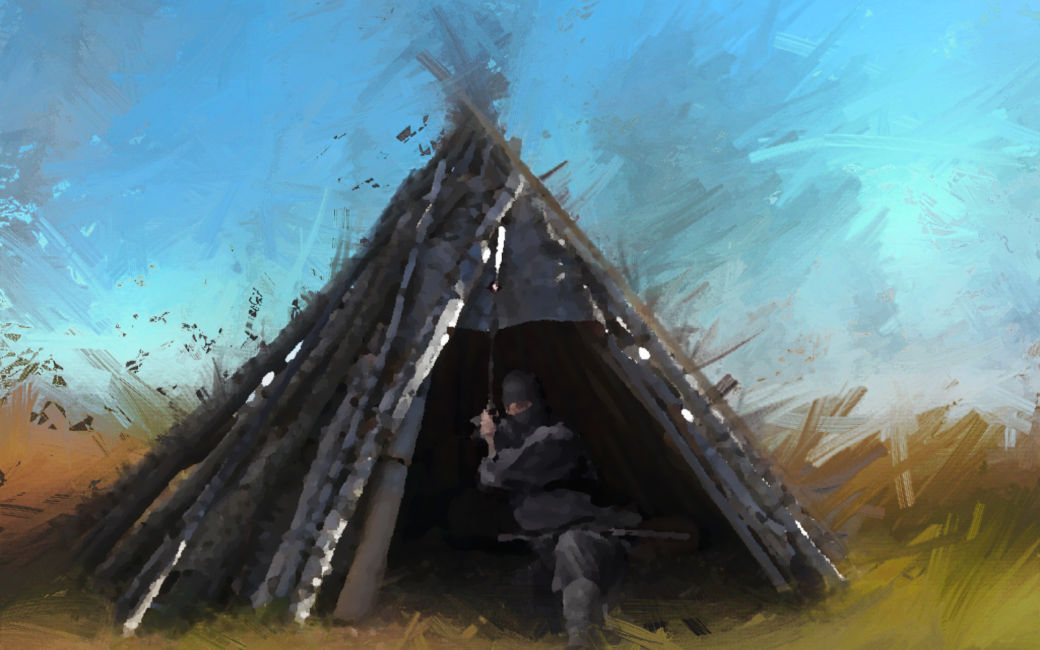 Shelter is at the core of what gives us a sense of safety, security, confidence, and protection. It is central to the mindset of perseverance, which is one translation of the Japanese term "nin", as in ninja. Imagine if you will a disruptive scenario...
Shelter is at the core of what gives us a sense of safety, security, confidence, and protection. It is central to the mindset of perseverance, which is one translation of the Japanese term "nin", as in ninja. Imagine if you will a disruptive scenario...
Picture an extreme weather event that suddenly sweeps through your home area. Let's say a hurricane or flood (or both) destroys your home. Beyond surviving the immediate event, a common reaction is the extreme emotional disruption caused by loss of a home. I'm sure you've seen this so many times in the news in recent years.
"We lost everything!" the voices say through tears on the news.
This scene unfortunately is playing out more and more each year with the changes occurring in our climate. It's a subject we covered in a recent blog, where we also discussed the value of the art of the ninja in dealing with this uncertain future.
But if you could put yourselves in these shoes, and imagine how you could prepare, adapt, and react, what would you do? As a former college athlete, our coach would routinely have us envision each race start to finish, so that when we actually competed, we had already been there. We had already achieved success in our minds. In Sensei Roemke's zoom classes, I often find myself training alone, having to imagine an invisible attacker. I find this often more valuable than training with a real partner as it develops my envisioning muscle. As a musician, I used to practice scales and songs with my hands invisibly on my desk in grade school algebra class.
My point is that practicing skills physically and mentally is key to developing the mindset when the skills are really needed.
In the survival skills teaching circles, some refer to a "sacred order" of survival skills: shelter, water, fire, food.
 There's lots of debate though about what is the first thing you should approach. Typically the landscape dictates which should come first. For example, if the temperature is sub-zero with a windchill, you might need to focus on fire. If you were lost in a desert environment, you likely would want to focus on water as a top priority. We interviewed survival skills specialist Tom McElroy for a ninja blog. I like his approach in one of his training videos where he sets up a water drip catchment system (from wild grape vines!) and then sets to work on a debris shelter. By time the shelter is done, he's thirsty. And guess what...there's a full bark container of fresh water waiting.
There's lots of debate though about what is the first thing you should approach. Typically the landscape dictates which should come first. For example, if the temperature is sub-zero with a windchill, you might need to focus on fire. If you were lost in a desert environment, you likely would want to focus on water as a top priority. We interviewed survival skills specialist Tom McElroy for a ninja blog. I like his approach in one of his training videos where he sets up a water drip catchment system (from wild grape vines!) and then sets to work on a debris shelter. By time the shelter is done, he's thirsty. And guess what...there's a full bark container of fresh water waiting.
My personal preference for the "sacred order" starts with attitude, or perseverance. In general though, the idea of shelter-first is often a worthy consideration. The thinking behind this is that you can survive for days to weeks without food. You can survive a handful of days without water (depending on the climate and landscape), but you can die of exposure within hours without adequate shelter.
 I remember learning this lesson many years ago when living in Hawaii. I was surfing at a river mouth north of Hilo on the Big Island. There had been a recent storm and lots of cold fresh water was rushing into the small bay where I waited for waves. Within a very short time my whole body was shaking and my fingernails were purple. I kept thinking, "How is this possible? I'm in Hawaii?!" When I tried to unlock my truck later, my hands were shaking so hard that I had a very difficult time getting the key in the slot. As I warmed up with the heater cranking in the front of the truck, I thought about how fast my body can lose heat, even in Hawaii.
I remember learning this lesson many years ago when living in Hawaii. I was surfing at a river mouth north of Hilo on the Big Island. There had been a recent storm and lots of cold fresh water was rushing into the small bay where I waited for waves. Within a very short time my whole body was shaking and my fingernails were purple. I kept thinking, "How is this possible? I'm in Hawaii?!" When I tried to unlock my truck later, my hands were shaking so hard that I had a very difficult time getting the key in the slot. As I warmed up with the heater cranking in the front of the truck, I thought about how fast my body can lose heat, even in Hawaii.
Learning to make a debris shelter changed my perspective on how to connect to a landscape, and what I truly needed to survive and be happy. I first learned this skill at a Tom Brown Tracker School course in California. We didn't actually build shelters at the course, but were instructed in the basic technique. The mission was to return to our home turf and try building one. If we returned for the follow-up course, then we would build and sleep in our shelters for an entire week.
 I returned to Hawaii. The location where I opted to try this skill was a friend's property in a native koa forest at an elevation of 4500' on the side of Mauna Loa.It is a wet place. I mean, really wet. It gets over 150 inches of rain some years. I knew it would be a challenge to stay dry and warm (the temperature dipped into the 40's at night).
I returned to Hawaii. The location where I opted to try this skill was a friend's property in a native koa forest at an elevation of 4500' on the side of Mauna Loa.It is a wet place. I mean, really wet. It gets over 150 inches of rain some years. I knew it would be a challenge to stay dry and warm (the temperature dipped into the 40's at night).
Despite lots of lush vegetation, the Hawaiian upper elevation wet forest did not provide the most ideal material in the form of debris on the ground. Plant material quickly decomposes under such wet conditions. I remember making an extremely leaky, damp, cold shelter that just wasn't going to work for the night.
I ended up sleeping under a tarp.
I was hungry too because my attempts to find wild edibles were dismal. There are few native plants at that elevation that are sufficient for the human digestive system. I remember falling asleep, hungry, under my tarp wondering how the native Hawaiians made shelter at these elevations in the past. My answer would come a few years later. But that's another story about water and shelter. I'll save that one for later.
 I returned to the Pine Barrens of New Jersey the following year, excited to build a debris shelter at the follow-up survival training course at the Tracker School. It was October and there were dry leaves everywhere! I worked on my shelter for 2-3 days in between lectures and other skills workshops. By time I was done, I had a giant mound of leaves and sticks about five feet high. I had made a door to keep the wind and rain out. I had even woven a reed mat as a sleeping pad. Thinking that the sound of the dawn chorus of birds would wake me, which usually happened in my tent, I went to sleep the first night without setting an alarm. My shelter was so soundproof that the next morning when I crawled out, I realized that I had not only missed breakfast, but the first lecture.
I returned to the Pine Barrens of New Jersey the following year, excited to build a debris shelter at the follow-up survival training course at the Tracker School. It was October and there were dry leaves everywhere! I worked on my shelter for 2-3 days in between lectures and other skills workshops. By time I was done, I had a giant mound of leaves and sticks about five feet high. I had made a door to keep the wind and rain out. I had even woven a reed mat as a sleeping pad. Thinking that the sound of the dawn chorus of birds would wake me, which usually happened in my tent, I went to sleep the first night without setting an alarm. My shelter was so soundproof that the next morning when I crawled out, I realized that I had not only missed breakfast, but the first lecture.
On the third night a huge storm hit. I could faintly detect the sound of thunder from inside my shelter. There was a torrential downpour as well, yet I stayed dry and warm. I didn't need a sleeping bag because of the warmth of all of the leaves.
On the fifth night I decided to sleep in my adjacent tent for comparison. The tent flapped all night long. I remember looking at the thin nylon walls, seeing my breath, and feeling so cold in my sleeping bag. I returned to my debris shelter for the rest of the week and slept happily.
 Sleeping in that debris shelter changed the way I viewed my camping relation to the outdoors. I felt the confidence that I didn't need a sleeping bag or tent, and if needed, I could make a comfortable shelter with just the materials from the forest around me. But most important for me was the deep sense of connection and gratitude– the feeling that the Earth provided me everything I needed for shelter.
Sleeping in that debris shelter changed the way I viewed my camping relation to the outdoors. I felt the confidence that I didn't need a sleeping bag or tent, and if needed, I could make a comfortable shelter with just the materials from the forest around me. But most important for me was the deep sense of connection and gratitude– the feeling that the Earth provided me everything I needed for shelter.
Not only was it a really fun, engaging activity of building this structure alone in the forest, but it instilled a deep sense of confidence within me that I liken to the positive attitude that martial arts training teaches. The feeling being– that if the proverbial dooky of doom really hit the fan, and I found myself in a desperate situation without shelter, I knew that I could at a bare minimum build a shelter from the landscape, and be engaged in doing so as a challenge instead of succumbing to panic.
Unless I was at 4500' on Mauna Loa. Then, I'd need another technique. But I digress again...
Since then, I have taught this skill countless times to youth and adults. It's amazing to watch kids build shelters. Go into any forest that abuts a neighborhood and you are likely to encounter piles of ramshackle sticks leaning against trees, a result of local kid's innate drive to build shelters in the forest. There's something deeply embedded within us that resonates with this skill.
At a Wilderness First Responder course, I remember an instructor discussing the idea that a lost child has a better chance of survival than an adult because most young kids have an instinct to seek shelter under bushes or leaves, whereas many adults panic and die of exposure.
 One of our favorite ways to introduce the basics of making a debris shelter is to create a "head shelter." This is a small scale version that incorporates all the essential components of a debris shelter: ridge pole, ribs, lattice, and debris. It's basically big enough to stick your head into.
One of our favorite ways to introduce the basics of making a debris shelter is to create a "head shelter." This is a small scale version that incorporates all the essential components of a debris shelter: ridge pole, ribs, lattice, and debris. It's basically big enough to stick your head into.
But, to make it a little more challenging, we throw in the "water test." What?!
The goal is to make a head shelter with enough debris that when a full water bottle is poured over the top, that the person's head inside the shelter stays dry. Or, if you are really brave...go for a gallon jug of water.
Once this shelter is learned, it's simply a matter of scaling up the size to fit an entire body.
This is a great one to do with a pack of ninja kids in the backyard. They especially enjoy pouring the water over the adult shelters.
We also talk about disappearing the shelters when done using them, to return the landscape to its prior condition. A good, sneaky ninja leaves no trace. But sometimes we have used these shelters to stash our dry fire wood on the periphery of our "ninja camps."
Below is a tutorial video showing one way to make the head shelters.
Because we are ninjas, we of course go hiking in the forest and use our hand-made hanbos for the ridge pole. Ninja secret– a full length rokushaku bo makes and awesome full size ridge pole for a debris shelter. But, if you find yourself in the forest without your hanbo or rokushaku bo, a tree branch will work.
Good luck with your head shelter!
